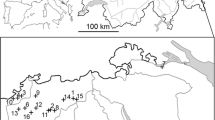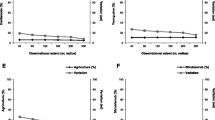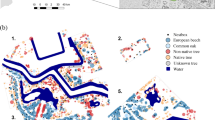Abstract
The factors influencing nest placement by territorial birds are not fully understood, including the roles played by habitat, conspecific attraction and female experience of a previous nesting location. We used 7 years of Marsh Tit (Poecile palustris) nest-site and territory data, and high-resolution vegetation models derived from remote sensing, to investigate spatial patterns of nest placement with regard to previous female experience and age, conspecific attraction, and habitat in a woodland environment. We found no evidence for an effect of conspecific attraction or previous nest location on nest placement within the territory. However, first-year (FY) females placed nests in a random spatial pattern within their territories, and after first-year (AFY) females predominantly placed nests within the central parts of their territories, away from conspecifics. The core area of each breeding territory was centred on a region of comparatively taller overstorey and less understorey than other parts of the territory. Nest-sites were situated in localised areas of a similar structure, although absolute differences between selected and non-selected areas of the territory were not substantial. Both female age groups nested in areas of the territory where the overstorey contained relatively more Common Ash (Fraxinus excelsior) and Field Maple (Acer campestre), which may have been related to tree height, but there was no selection for English Oak (Quercus robur). We found no significant habitat differences between the territories of FY and AFY females that explained their differing patterns of nest placement.
Zusammenfassung
Nistplatzwahl in einer Population von Sumpfmeisen Poecile palustris
Die Faktoren, die die Nistplatzwahl territorialer Vogelarten beeinflussen, sind nicht gänzlich verstanden. Dies beinhaltet die Funktion des Habitats, innerartliche Attraktion, aber auch die Erfahrung der Weibchen mit früheren Neststandorten. Mit Hilfe eines Datensatzes aus sieben Jahren zu Nistplätzen und Revieren von Sumpfmeisen (Poecile palustris) sowie hoch aufgelösten Vegetationsmodellen (aus Fernerkundungsdaten hergeleitet) untersuchten wir räumliche Muster der Nistplatzwahl im Hinblick auf Alter und Erfahrung der Weibchen, innerartliche Attraktion und Habitat in einem Waldgebiet. Wir fanden keine Beweise für einen Effekt der innerartlichen Attraktion oder früherer Neststandorte auf die Nistplatzwahl innerhalb der Reviere. Allerdings legten vorjährige Weibchen, räumlich gesehen, ihre Nester innerhalb ihrer Reviere in einem zufälligen Muster an. Ältere Weibchen legten dagegen ihre Nester überwiegend in den zentralen Bereichen ihrer Reviere an, abseits von Artgenossen. Das Kerngebiet der einzelnen Brutreviere lag in Bereichen mit vergleichsweise höherem Oberholz und weniger Unterholz als in anderen Bereichen der Reviere. Die Neststandorte befanden sich in Bereichen mit ähnlicher Struktur, obwohl grundsätzliche Unterschiede zwischen gewählten und nicht gewählten Bereichen innerhalb der Reviere nicht substantiell waren. Beide Altersgruppen der Weibchen nisteten in Bereichen der Brutreviere, in denen die höherwüchsige Struktur relativ mehr aus Gewöhnlicher Esche (Fraxinus excelsior) und Feldahorn (Acer campestre) bestand, was mit der Baumhöhe zusammenhängen könnte. Allerdings gab es keine Selektion für Stieleichen (Quercus robur). Wir fanden keine signifikanten Habitatunterschiede zwischen den Revieren der beiden Altersgruppen der Weibchen, die die Verteilung der Neststandorte erklären.
Similar content being viewed by others

References
Atiénzar F, Barba E, Holleman LJM, Belda EJ (2009) Nesting habitat requirements and nestling diet in the Mediterranean populations of the crested tits Lophophones cristatus. Acta Ornithol 44(2):101–108
Bayard TS, Elphick CS (2010) Using spatial point-pattern assessment to understand the social and environmental mechanisms that drive avian habitat selection. Auk 127(3):485–494
Bibby CJ, Burgess ND, Hill DA, Mustoe SH (2000) Bird census techniques, 2nd edn. Academic, London
Bonnot TW, Millspaugh JJ, Rumble MA (2009) Multi-scale nest-site selection by black-backed woodpeckers in outbreaks of mountain pine beetles. For Ecol Manag 259:220–228
Bradbury RB, Hill RA, Mason DC, Hinsley SA, Wilson JD, Balzter H, Anderson GQA, Whittingham MJ, Davenport IJ, Bellamy PE (2005) Modelling relationships between birds and vegetation structure using airborne LIDAR data: a review with case studies from agricultural and woodland environments. Ibis 147:443–452
Broughton RK, Hinsley SA, Bellamy PE, Hill RA, Rothery P (2006) Marsh tit Poecile palustris territories in a British broadleaved wood. Ibis 148:744–752
Broughton RK, Hinsley SA, Bellamy PE, Carpenter JE, Rothery P (2008) Ageing and sexing marsh tits Poecile palustris using wing length and moult. Ring Migr 24:88–94
Broughton RK, Hill RA, Bellamy PE, Hinsley SA (2010) Dispersal, ranging and settling behaviour of marsh tits Poecile palustris in a fragmented landscape in lowland England. Bird Study 57(4):458–472
Broughton RK, Hill RA, Bellamy PE, Hinsley SA (2011) Nest-sites, breeding failure, and causes of non-breeding in a population of British marsh tits Poecile palustris. Bird Study 58(3):229–237
Burger J (1987) Physical and social determinants of nest-site selection in piping plover in New Jersey. Condor 89:811–818
Carpenter JE (2008) An investigation of causes of population decline in the marsh tit Poecile palustris in Britain. DPhil dissertation, Oxford University
Carpenter J, Smart J, Amar A, Gosler A, Hinsley S, Charman E (2010) National scale analyses of habitat associations of marsh tits Poecile palustris and blue tits Cyanistes caeruleus: two species with opposing population trends in Britain. Bird Study 57(1):31–43
Elston DA, Illius AW, Gordon IJ (1996) Assessment of preference among a range of options using log ratio analysis. Ecology 77:2538–2548
Fuller RM, Devereux BJ, Gillings S, Amable GS, Hill RA (2005) Indices of bird-habitat preference from bird field surveys and remote sensing of land cover: a study of south-eastern England with wider implications for conservation and biodiversity assessment. Glob Ecol Biogeogr 14:223–239
Goetz SJ, Steinberg D, Betts MG, Holmes RT, Doran PJ, Dubayah R, Hofton M (2010) Lidar remote sensing variables predict breeding habitat of a Neotropical migrant bird. Ecology 91(6):1569–1576
Gottschalk TK, Huettmann F, Ehlers M (2005) Thirty years of analyzing and modeling avian habitat relationships using satellite imagery data: a review. Int J Remote Sens 26(12):2631–2656
Hill RA, Broughton RK (2009) Mapping the understorey of deciduous woodland from leaf-on and leaf-off airborne LiDAR data: a case study in lowland Britain. ISPRS J Photogramm 64:223–233
Hill RA, Thomson AG (2005) Mapping woodland species composition and structure using airborne spectral and LiDAR data. Int J Remote Sens 26:3763–3779
Hill RA, Gaveau DLA, Spendlove M (2002) Accuracy issues in the assessment of deciduous woodland canopy height by airborne laser scanning. In: Operational tools in forestry using remote sensing techniques. ForestSAT Symposium 2002. Heriot Watt University, Edinburgh
Hill RA, Wilson AK, George M, Hinsley SA (2010) Mapping tree species in temperate deciduous woodland using time-series multi-spectral data. Appl Veg Sci 13:86–99
Hinsley SA, Carpenter JE, Broughton RK, Bellamy PE, Rothery P, Amar A, Hewson CM, Gosler AG (2007) Habitat selection by marsh tits Poecile palustris in the UK. Ibis 149(Suppl. 2):2–13
Jones J, Robertson RJ (2001) Territory and nest-site selection of cerulean warblers in Eastern Ontario. Auk 118:727–735
Koivula K, Lahti K, Orell M, Rytkönen S (1993) Prior residency as a key determinant of dominance in the willow tit (Parus montanus). Behav Ecol Sociobiol 33:283–287
Lefsky MA, Cohen WB, Parker GG, Harding DJ (2002) Lidar remote sensing for ecosystem studies. Bioscience 52:19–30
Lim K, Treitz P, Wulder M, St-Onge B, Flood M (2003) LiDAR remote sensing of forest structure. Prog Phys Geog 27:88–106
Mänd R, Leivits A, Leivits M, Rodenhouse NL (2009) Provision of nestboxes raises the breeding density of great tits Parus major equally in coniferous and deciduous woodland. Ibis 151:487–492
Martin TE (1993) Nest predation among vegetation layers and habitat types: revising the dogmas. Am Nat 141:897–913
Martinuzzi S, Vierling LA, Gould WA, Falkowski MJ, Evans JS, Hudak AT, Vierling KT (2009) Mapping snags and understory shrubs for a LiDAR-based assessment of wildlife habitat suitability. Remote Sens Environ 113:2533–2546
Marzluff JM (1988) Do pinyon jays alter nest placement based on prior experience? Anim Behav 36:1–10
Melles SJ, Badzinski D, Fortin M-J, Csillag F, Lindsay K (2009) Disentangling habitat and social drivers of nesting patterns in songbirds. Landsc Ecol 24(4):519–531
Mennill DJ, Ramsay SM, Boag PT, Ratcliffe LM (2004) Patterns of extrapair mating in relation to male dominance status and female nest placement in black-capped chickadees. Behav Ecol 15(5):757–765
Morley A (1953) Field observations on the biology of the marsh tit: (4) breeding behavior. Br Birds 46(9):332–346
Muller KL, Stamps JA, Krishnan VV, Willits NH (1997) The effect of conspecific attraction and habitat quality on habitat selection in territorial birds (Troglodytes aedon). Am Nat 150(5):650–661
Nilsson SG (1984) The evolution of nest site selection among hole-nesting birds: the importance of nest predation and competition. Ornis Scand 15:167–175
Nilsson J-Å, Smith HG (1988) Effects of dispersal date on winter flock establishment and social dominance in marsh tits Parus palustris. J Anim Ecol 57:917–928
Oppel S (2004) Habitat selection by the pale-headed brush-finch (Atlapetes pallidiceps) in southern Ecuador: Implications for conservation. Biol Conserv 118:33–40
Quine CP, Fuller RJ, Smith KW, Grice PV (2007) Stand management: a threat or an opportunity for birds in British woodland? Ibis 149(Suppl. 2):161–174
Ramsay SM, Otter K, Ratcliffe LM (1999) Nest site selection by female black-capped chickadees: settlement based on conspecific attraction? Auk 116(3):604–617
Schubert KA, Mennill DJ, Ramsay SM, Otter KA, Boag PT, Ratcliffe LM (2007) Variation in social rank acquisition influences lifetime reproductive success in black-capped chickadees. Biol J Linn Soc 90:85–95
Sockman KW (2000) Seasonal variation in nest placement by the California gnatcatcher. Wilson Bull 112:498–504
Stenning MJ (2008) Hatching asynchrony and brood reduction in Blue Tits Cyanistes caeruleus may be a plastic response to local oak Quercus robur bud burst and caterpillar emergence. Acta Ornithol 43:97–106
Summers RW, Taylor W, Underhill LG (1992) Nesting habitat selection by crested tits Parus cristatus in a pine plantation. Forestry 66:147–151
Weatherhead PJ, Montgomerie R, Gibbs HL, Boag PT (1994) The cost of extra-pair fertilizations to female red-winged blackbirds. Proc R Soc Lond B 258:315–320
Wesołowski T (1996) Natural nest sites of marsh tits (Parus palustris) in a primaeval forest (Białowieża National Park, Poland). Die Vogelwarte 38:235–249
Wesołowski T (2000) Time-saving mechanisms in the reproduction of marsh tits (Parus palustris). J Ornithol 141:309–318
Wesołowski T (2006) Nest site re-use: marsh tit Poecile palustris decisions in a primeval forest. Bird Study 53:199–2005
Westneat DF, Mays HL (2005) Tests of spatial and temporal factors influencing extra-pair paternity in red-winged blackbirds. Mol Ecol 14:2155–2167
Wilkin TA, King LE, Sheldon BC (2009) Habitat quality, nestling diet and food-provisioning behaviour in great tits Parus major. J Avian Biol 40(2):135–145
Acknowledgments
The authors thank Natural England for access to Monks Wood National Nature Reserve and private landowners for access to the Eastern Woods, Dr. Stephen N. Freeman for statistical support, Dr. Daria Dadam and Dr. Jane Carpenter for additional fieldwork, and the three anonymous reviewers of the manuscript. This work was funded by the Natural Environment Research Council (NERC). The remote sensing data were acquired by the NERC Airborne Research and Survey facility (ARSF) in conjunction with the Unit for Landscape Modelling (ULM) at the University of Cambridge. All ringing activities were licensed by the British Trust for Ornithology, and complied with UK law. The authors declare that they have no conflict of interest. Richard K Broughton is a Visiting Research Fellow at Bournemouth University, UK.
Author information
Authors and Affiliations
Corresponding author
Additional information
Communicated by T. Gottschalk.
Rights and permissions
About this article
Cite this article
Broughton, R.K., Hill, R.A., Henderson, L.J. et al. Patterns of nest placement in a population of Marsh Tits Poecile palustris . J Ornithol 153, 735–746 (2012). https://doi.org/10.1007/s10336-011-0790-2
Received:
Revised:
Accepted:
Published:
Issue Date:
DOI: https://doi.org/10.1007/s10336-011-0790-2



